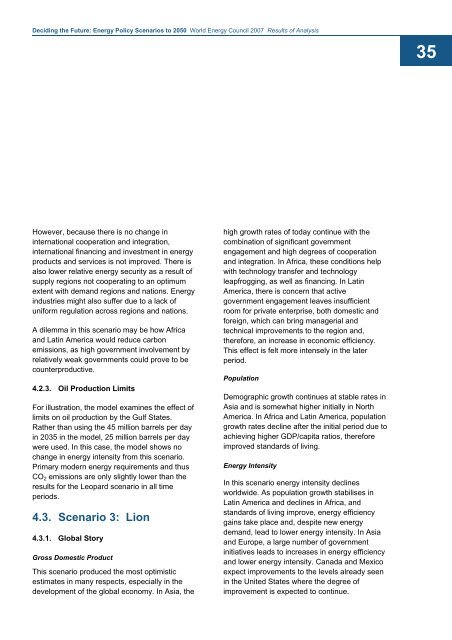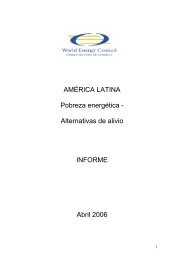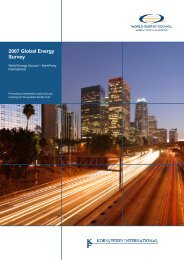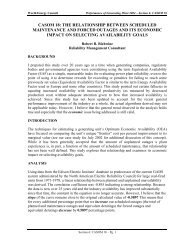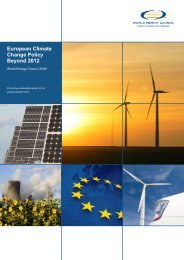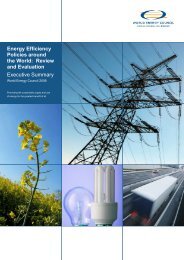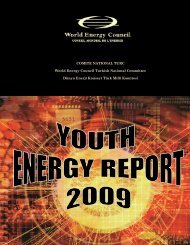Deciding the Future: Energy Policy Scenarios to 2050
Deciding the Future: Energy Policy Scenarios to 2050
Deciding the Future: Energy Policy Scenarios to 2050
Create successful ePaper yourself
Turn your PDF publications into a flip-book with our unique Google optimized e-Paper software.
<strong>Deciding</strong> <strong>the</strong> <strong>Future</strong>: <strong>Energy</strong> <strong>Policy</strong> <strong>Scenarios</strong> <strong>to</strong> <strong>2050</strong> World <strong>Energy</strong> Council 2007 Results of Analysis<br />
35<br />
However, because <strong>the</strong>re is no change in<br />
international cooperation and integration,<br />
international financing and investment in energy<br />
products and services is not improved. There is<br />
also lower relative energy security as a result of<br />
supply regions not cooperating <strong>to</strong> an optimum<br />
extent with demand regions and nations. <strong>Energy</strong><br />
industries might also suffer due <strong>to</strong> a lack of<br />
uniform regulation across regions and nations.<br />
A dilemma in this scenario may be how Africa<br />
and Latin America would reduce carbon<br />
emissions, as high government involvement by<br />
relatively weak governments could prove <strong>to</strong> be<br />
counterproductive.<br />
4.2.3. Oil Production Limits<br />
For illustration, <strong>the</strong> model examines <strong>the</strong> effect of<br />
limits on oil production by <strong>the</strong> Gulf States.<br />
Ra<strong>the</strong>r than using <strong>the</strong> 45 million barrels per day<br />
in 2035 in <strong>the</strong> model, 25 million barrels per day<br />
were used. In this case, <strong>the</strong> model shows no<br />
change in energy intensity from this scenario.<br />
Primary modern energy requirements and thus<br />
CO 2 emissions are only slightly lower than <strong>the</strong><br />
results for <strong>the</strong> Leopard scenario in all time<br />
periods.<br />
4.3. Scenario 3: Lion<br />
4.3.1. Global S<strong>to</strong>ry<br />
Gross Domestic Product<br />
This scenario produced <strong>the</strong> most optimistic<br />
estimates in many respects, especially in <strong>the</strong><br />
development of <strong>the</strong> global economy. In Asia, <strong>the</strong><br />
high growth rates of <strong>to</strong>day continue with <strong>the</strong><br />
combination of significant government<br />
engagement and high degrees of cooperation<br />
and integration. In Africa, <strong>the</strong>se conditions help<br />
with technology transfer and technology<br />
leapfrogging, as well as financing. In Latin<br />
America, <strong>the</strong>re is concern that active<br />
government engagement leaves insufficient<br />
room for private enterprise, both domestic and<br />
foreign, which can bring managerial and<br />
technical improvements <strong>to</strong> <strong>the</strong> region and,<br />
<strong>the</strong>refore, an increase in economic efficiency.<br />
This effect is felt more intensely in <strong>the</strong> later<br />
period.<br />
Population<br />
Demographic growth continues at stable rates in<br />
Asia and is somewhat higher initially in North<br />
America. In Africa and Latin America, population<br />
growth rates decline after <strong>the</strong> initial period due <strong>to</strong><br />
achieving higher GDP/capita ratios, <strong>the</strong>refore<br />
improved standards of living.<br />
<strong>Energy</strong> Intensity<br />
In this scenario energy intensity declines<br />
worldwide. As population growth stabilises in<br />
Latin America and declines in Africa, and<br />
standards of living improve, energy efficiency<br />
gains take place and, despite new energy<br />
demand, lead <strong>to</strong> lower energy intensity. In Asia<br />
and Europe, a large number of government<br />
initiatives leads <strong>to</strong> increases in energy efficiency<br />
and lower energy intensity. Canada and Mexico<br />
expect improvements <strong>to</strong> <strong>the</strong> levels already seen<br />
in <strong>the</strong> United States where <strong>the</strong> degree of<br />
improvement is expected <strong>to</strong> continue.


